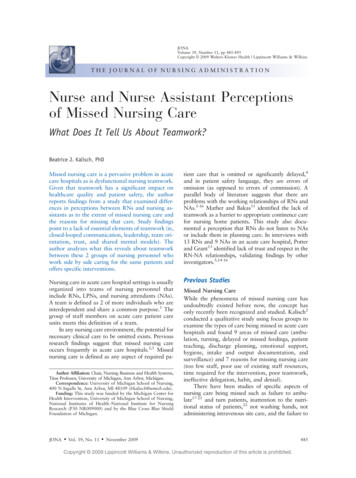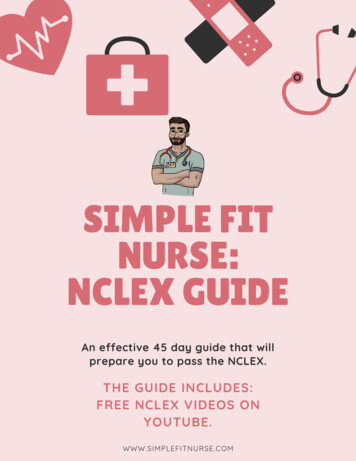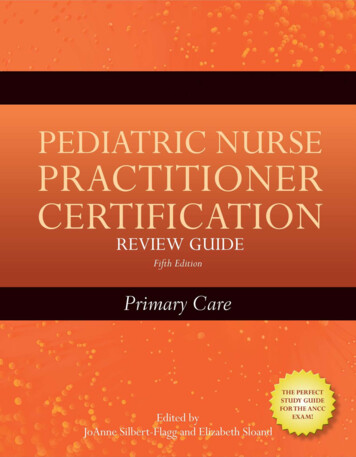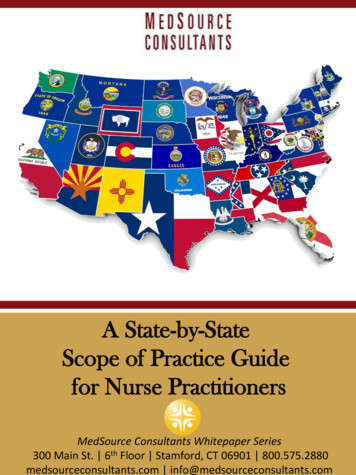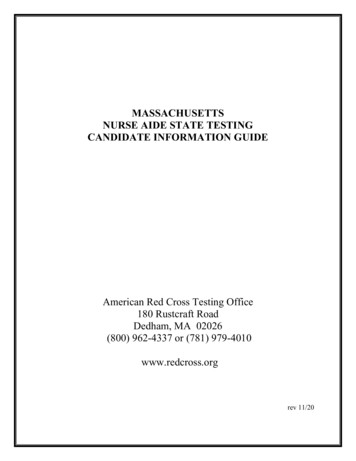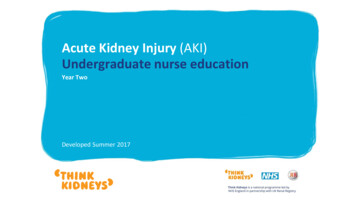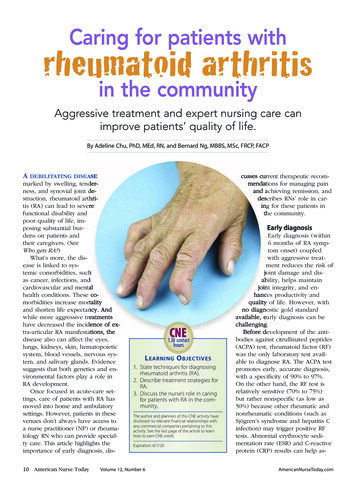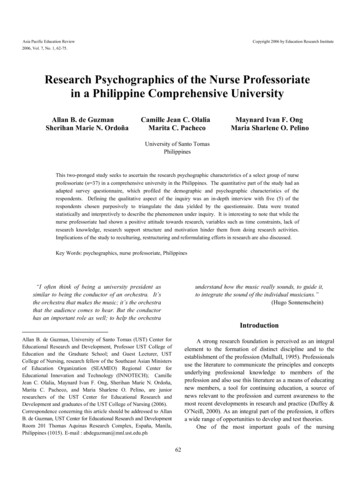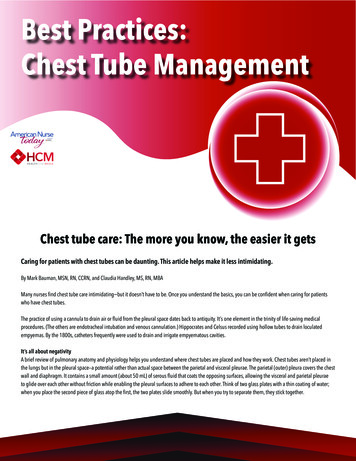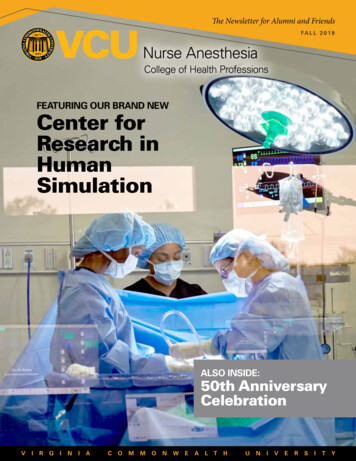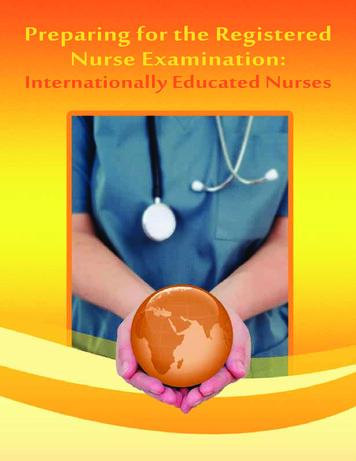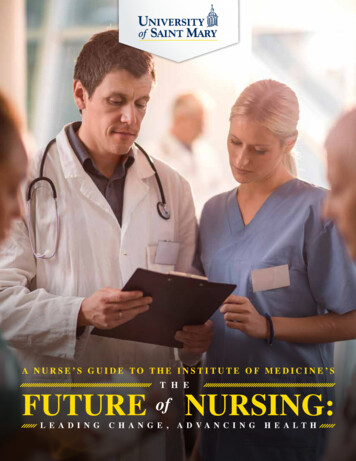
Transcription
A N u r s e ’ s G u i d e t o t h e In s t i t u t e o f M e d i c i n e ’ sFuture of Nursing:THEL e a d i n gC h a n g e ,A d v a nc i n gH e a lt h
In 2010, the Institute of Medicine (IOM) released a report called “The Future of Nursing: Leading Change,Advancing Health.” As an agenda for the nursing profession in the 21st century, this document is making amassive impact on nurses, health care organizations, and legislation.Many nurses have questions about the report and how it will affect them and the field. This brief summary isintended to provide a greater understanding of its contents and how you can prepare for the changing healthcare environment. The full, detailed report is available on the IOM’s website at iom.nationalacademies.org.2A Nurse’s Guide to the Institute of Medicine’s“The Future of Nursing: Leading Change, Advancing Health.”
Four Key FindingsThe IOM report’s ultimate goal is to improve health care and patient outcomes through nursing practiceand policies. In four key messages, the report details the way changes in health care due to technology,demographics, and other factors are affecting expectations and demands on nursing.1Nurses should practice to the full extent of theireducation and training.Nurses may have an exceptional amount of education and experience, butthey may not be able to use all of it for various reasons, including:Historical, regulatory, and policy barriers.A complex, fragmented health care system.Differences in state laws regarding nursing practice.Nurses should achieve higher levels of education andtraining through an improved education system thatpromotes seamless academic progression.Nursing core competencies have greatly expanded in the last severaldecades to include public health, geriatrics, leadership, teamwork, andchange management. In addition, nurses are caring for more patients withcomplex issues, using more technology, and collecting and synthesizinginformation from several sources to determine optimal patient care.All of these factors point to a need for higher education standards aswell as easier access to nursing degree programs at all degree levels.Online programs, such as the RN to Bachelor of Science in Nursing andMaster of Science in Nursing at the University of Saint Mary, can be aconvenient and flexible alternative to on-campus programs.3A Nurse’s Guide to the Institute of Medicine’s“The Future of Nursing: Leading Change, Advancing Health.”2
Four Key Findings3Nurses should be full partners with physicians andother health professionals in redesigning health carein the United States.To support nurses’ expanded role in health care today, the report suggestsvarious actions including:Formally recognizing leadership skills as core competencies andimplementing them into nursing program curricula.Encouraging more nurses to join committees, commissions, andboards to have a greater say in health care policies.Effective workforce planning and policy makingrequire better data collection and an improvedinformation infrastructure.The report recommends that the health care industry create an organizedmethod for collecting detailed data on:The numbers and types of health care professionals across the U.S.Where they are employed.Their roles, activities, and duties.This information will help identify where health care needs are being metand where they are falling short. The findings can then be used to planfuture nursing workforce requirements more effectively, as well as identifytrends that might affect nursing practice and education needs.4A Nurse’s Guide to the Institute of Medicine’s“The Future of Nursing: Leading Change, Advancing Health.”4
Eight Recommendations for Change“The Future of Nursing” goes on to provide eight recommendations for taking action to carry out the goals identifiedin the key messages.1Remove scope-of-practice barriers.State laws regulating the practice of nursing vary widely, as do rules indifferent settings and organizations. For instance, a nurse in an Oklahomaoutpatient clinic may not be legally able to provide the same services as anurse in another facility in Michigan. To remove barriers and standardizenursing practice, the report suggests actions including:Expand Medicare to cover certain nursing services.Call on the Federal Trade Commission and the Department ofJustice to review state regulations on nurses that restrict theservices they can offer.Expand opportunities for nurses to lead and diffusecollaborative improvement efforts.Suggestions for accomplishing this include:Health care organizations should actively encourage nurses todevelop innovative, patient-centered models for care.Ask nurses for input and feedback on the design, development,implementation, and evaluation of health care technologyand devices.Provide entrepreneurial training and development to help nursescreate their own health care initiatives.5A Nurse’s Guide to the Institute of Medicine’s“The Future of Nursing: Leading Change, Advancing Health.”2
Eight Recommendations for Change3Implement nurse residency programs.The report found that a residency period could help ease nurses’ initialtransition from education to practice, or the transition to a different clinicalpractice, by providing psychological and professional support. To promotemore residencies, the report suggests:Redirect funding for diploma nursing programs to implementnurse residency programs in areas facing a critical lack of healthcare access.Procure funding for nurse residencies from healthcare companies, government agencies, andphilanthropic organizations.Increase the proportion of nurses with abaccalaureate degree to 80 percent by 2020.Health care has grown so complex that nurses today need skills incritical-thinking and evidence-based practice — skills that are developedin Bachelor of Science in Nursing degree programs such as the onlineRN-BSN at the University of Saint Mary. To encourage more nurses toearn a BSN,Nursing accrediting bodies should require nursing schools toprovide defined academic pathways, such as the RN-BSN.Health care organizations should offer tuition reimbursementand clear salary increase and promotion opportunities.Nurse leaders in academia should partner with health careorganizations and secondary schools to recruit nursing studentsfrom diverse backgrounds.6A Nurse’s Guide to the Institute of Medicine’s“The Future of Nursing: Leading Change, Advancing Health.”4
Eight Recommendations for Change5Double the number of nurses with a doctorate by 2020.The shortage of nursing faculty has long been an area of concern.Encouraging more nurses to earn doctorates adds to the supply of instructorsas well as researchers who can help the profession evolve.To do so, the report suggests:Monitor nursing school graduates to ensure that at least 10percent of BSN graduates undertake a master’s or doctoraldegree program within five years of their graduation.Expand private and public funding for accelerated graduatedegree programs in nursing.Make salaries and benefits packages for academic and clinicalnurse faculty competitive with other nursing specialties.Ensure that nurses engage in lifelong learning.Health care moves so quickly that nurses are already learning constantly.Supporting lifelong learning with dedicated resources can help themmake an even greater impact on patient care, as well as their owncareers. The report suggests that:Schools should collaborate with health care organizations toensure that nursing coursework aligns with present and futurehealth needs.Health care organizations offering continuing education shouldregularly evaluate and update their own programs.7A Nurse’s Guide to the Institute of Medicine’s“The Future of Nursing: Leading Change, Advancing Health.”6
Eight Recommendations for Change7Prepare and enable nurses to lead change toadvance health.Public, private, and government health care decision makersshould actively work toward promoting more nurses forleadership positions.Nursing associations should developleadership-training programs.Nurses should expand their presence on boards, executiveteams, and other leadership bodies.Build an infrastructure for the collection and analysisof interprofessional health care workforce data.More workforce data can provide insights into gaps in nursing and otherhealth care services across the country. The report suggests various waysgovernment agencies could go about this:Develop and distribute a standardized set of data that can be usedto assess health care workforce needs by demographics, numbers,skill mix, and geographic distribution.Measure and monitor the collected data to forecast futurenursing workforce requirements.The Department of Labor, educators, and employers shouldcollaborate to pinpoint workforce gaps and create plans forfilling them.8A Nurse’s Guide to the Institute of Medicine’s“The Future of Nursing: Leading Change, Advancing Health.”8
FutureL e a d i n gNursing:THEofC h a n g e ,A d v a nc i n gH e a lt hFour Key Findings1Nurses should practice to the full extent of their education and training.2Nurses should achieve higher levels of education and training through an improved education system that promotesseamless academic progression.3Nurses should be full partners with physicians and other health professionals in redesigning health care in theUnited States.4Effective workforce planning and policy making require better data collection and an improved information infrastructure.Eight Recommendations for Change1Remove scope-of-practice barriers.5Double the number of nurses with a doctorateby 2020.2Expand opportunities for nurses to lead and diffusecollaborative improvement efforts.6Ensure that nurses engage in lifelong learning.3Implement nurse residency programs.7Prepare and enable nurses to lead change toadvance health.4Increase the proportion of nurses with abaccalaureate degree to 80 percent by 2020.8Build an infrastructure for the collection and analysisof interprofessional health care workforce data.How will the Future of Nursing Impact you?Take the first step toward ensuring that you are prepared for the changing health care landscape outlined in “The Future of Nursing.”The online RN to Bachelor of Science in Nursing and Master of Science in Nursing degrees at the University of Saint Mary align withthe competencies and goals recommended by the Institute of Medicine. Develop your skills and take advantage of opportunities intoday’s health care environment — as well as tomorrow’s.o nl i n e . s t m a r y . e d u 8 7 7 - 3 0 7 - 4 9 1 5
Monitor nursing school graduates to ensure that at least 10 percent of BsN graduates undertake a master’s or doctoral degree program within five years of their graduation. expand private and public funding for accelerated graduate degree programs in nursing. Make
